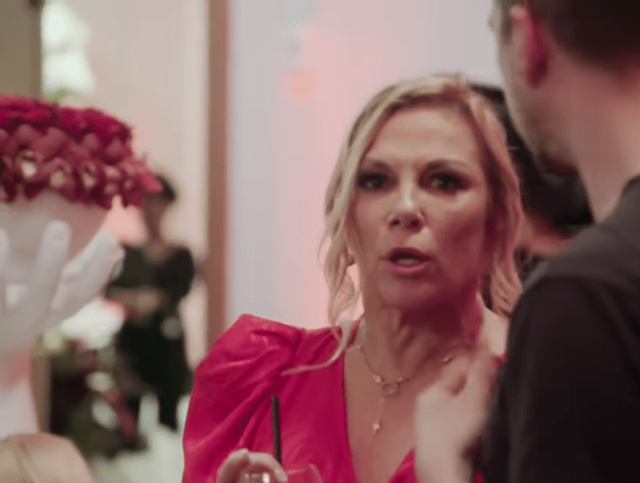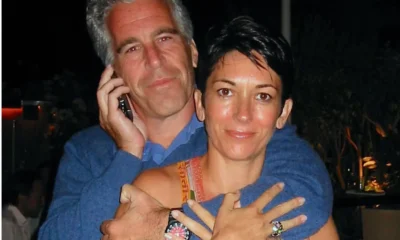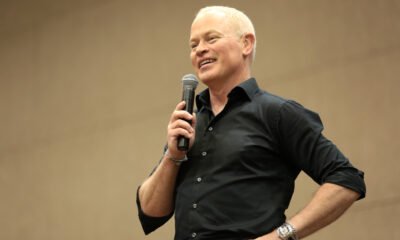Entertainment
Ramona Singer No Longer Holds Real Estate Job After Racial Slur Scandal, Removal from … on November 3, 2023 at 10:53 pm The Hollywood Gossip

This isn’t the first time that Ramona Singer has come to regret her words.
The RHONY alum doesn’t have a reputation for being particularly bright or decent, but there are lines that no one should cross. Not if they’re a public figure hoping to keep their job.
We’re not talking about just a Bravo gig, either. Ramona has reportedly lost her real estate job after less than two years.
Why? Well, it sure looks a lot like a vile racial slur was part of the story.
There are times when Ramona Singer’s facial expression shows bewilderment and confusion. (Image Credit: Bravo)
Entertainment Tonight reports that Ramona Singer is no longer working as a real estate agent at Douglas Elliman.
Stephen Larkin, the Executive Vice President & Chief Communications Officer for the company, confirmed as much with a terse statement.
“She is no longer with Douglas Elliman” is a clear statement, but it leaves unanswered questions.
“I don’t have the virus, I tested today,” Ramona Singer announces during a contentious RHONY Reunion. (Image Credit: Bravo)
Obviously, we cannot claim to know the inner workings of a real estate firm.
However, one cannot help but note the timing of this news.
Ramona has been at the heart of a controversy in the wake of Vanity Fair‘s in-depth article about Bravo.
Ramona Singer attends Angel Ball 2022 hosted by Gabrielle’s Angel Foundation at Cipriani Wall Street on October 24, 2022. (Photo Credit: Jamie McCarthy/Getty Images for Gabrielle’s Angel Foundation)
During the article (which covered so, so many topics), we found a familiar claim.
The allegation is that Singer used a racial slur during the production of The Real Housewives of New York City Season 13.
According to the report, she directed this unspeakable term toward a Black member of the production crew.
Ramona Singer attends the Dennis Basso fashion show during September 2022. (Photo Credit: Steven Simione/Getty Images for NYFW: The Shows)
According to Variety‘s report, it appears that Ramona’s incident led to the filing of a formal complaint against the show’s production.
The complaint extended to production’s parent companies.
So that’s Shed Media, Warner Bros. Discovery, Bravo, and NBCUniversal.
Ramona Singer appears here on Watch What Happens Live. The appearance was taped in July 2018. (Image Credit: Bravo)
During the investigation, Singer insisted that she had not used the racial slur.
The internal investigation (which, as we are all aware, exists to protect companies from liability) considered the matter “inconclusive.” That’s pretty much what we expected.
However, it appears that the fallout from this continues to impact her relationship with Bravo.
Ramona Singer wears a rose gold dress in a promotional shot from The Real Housewives of New York Season 12. (Photo Credit: Bravo)
For one thing, Singer sent a text message to a Page Six reporter in which she attempted to downplay her alleged use of the racial slur.
Obviously, this did not help matters. It also did not make her look innocent.
After all of this, BravoCon somewhat quietly removed Ramona from attendance. That’s this upcoming BravoCon in Vegas, by the way.
Ramona Singer is ready for her close-up on The Real Housewives of New York Season 9. (Image Credit: Bravo)
It is difficult to imagine that none of this is related to Singer’s departure from the firm that, just two years ago, she seemed so excited to join.
The real estate agency even created an advertisement to cite her addition to their team. Whoops!
Honestly, there’s just never a reason to use slurs that would not be directed at you personally. Sadly, no part of these claims are surprising when it comes to Ramona. She is who she has chosen to be.
Ramona Singer No Longer Holds Real Estate Job After Racial Slur Scandal, Removal from … was originally published on The Hollywood Gossip.
This isn’t the first time that Ramona Singer has come to regret her words. The RHONY alum doesn’t have a …
Ramona Singer No Longer Holds Real Estate Job After Racial Slur Scandal, Removal from … was originally published on The Hollywood Gossip.
The Hollywood Gossip Read More
Entertainment
What We Can Learn Inside 50 Cent’s Explosive Diddy Documentary: 5 Reasons You Should Watch

50 Cent’s new Netflix docuseries about Sean “Diddy” Combs is more than a headline-grabbing exposé; it is a meticulous breakdown of how power, celebrity, and silence can collide in the entertainment industry.
Across its episodes, the series traces Diddy’s rise, the allegations that followed him for years, and the shocking footage and testimonies now forcing a wider cultural reckoning.

1. It Chronicles Diddy’s Rise and Fall – And How Power Warps Reality
The docuseries follows Combs from hitmaker and business icon to a figure facing serious criminal conviction and public disgrace, mapping out decades of influence, branding, and behind-the-scenes behavior. Watching that arc shows how money, fame, and industry relationships can shield someone from scrutiny and delay accountability, even as disturbing accusations accumulate.

2. Never-Before-Seen Footage Shows How Narratives Are Managed
Exclusive footage of Diddy in private settings and in the tense days around his legal troubles reveals how carefully celebrity narratives are shaped, even in crisis.
Viewers can learn to question polished statements and recognize that what looks spontaneous in public is often the result of strategy, damage control, and legal calculation.
3. Survivors’ Stories Highlight Patterns of Abuse and Silence
Interviews with alleged victims, former staff, and industry insiders describe patterns of control, fear, and emotional or physical harm that were long whispered about but rarely aired in this detail. Their stories underline how difficult it is to speak out against a powerful figure, teaching viewers why many survivors delay disclosure and why consistent patterns across multiple accounts matter.
4. 50 Cent’s Approach Shows Storytelling as a Tool for Accountability
As executive producer, 50 Cent uses his reputation and platform to push a project that leans into uncomfortable truths rather than protecting industry relationships. The series demonstrates how documentary storytelling can challenge established power structures, elevate marginalized voices, and pressure institutions to respond when traditional systems have failed.
5. The Cultural Backlash Reveals How Society Handles Celebrity Accountability
Reactions to the doc—ranging from people calling it necessary and brave to others dismissing it as a vendetta or smear campaign—expose how emotionally invested audiences can be in defending or condemning a famous figure. Watching that debate unfold helps viewers see how fandom, nostalgia, and bias influence who is believed, and why conversations about “cancel culture” often mask deeper questions about justice and who is considered too powerful to fall.
Entertainment
South Park’s Christmas Episode Delivers the Antichrist

A new Christmas-themed episode of South Park is scheduled to air with a central plot in which Satan is depicted as preparing for the birth of an Antichrist figure. The premise extends a season-long narrative arc that has involved Satan, Donald Trump, and apocalyptic rhetoric, positioning this holiday episode as a culmination of those storylines rather than a stand‑alone concept.
Episode premise and season context
According to published synopses and entertainment coverage, the episode frames the Antichrist as part of a fictional storyline that blends religious symbolism with commentary on politics, media, and cultural fear. This follows earlier Season 28 episodes that introduced ideas about Trump fathering an Antichrist child and tech billionaire Peter Thiel obsessing over prophecy and end‑times narratives. The Christmas setting is presented as a contrast to the darker themes, reflecting the series’ pattern of pairing holiday imagery with controversial subject matter.
Public and political reactions
Coverage notes that some figures connected to Donald Trump’s political orbit have criticized the season’s portrayal of Trump and his allies, describing the show as relying on shock tactics rather than substantive critique. Commentators highlight that these objections are directed more at the depiction of real political figures and the show’s tone than at the specific theology of the Antichrist storyline.
At the time of reporting, there have not been widely reported, detailed statements from major religious leaders focused solely on this Christmas episode, though religion-focused criticism of South Park in general has a long history.
Media and cultural commentary
Entertainment outlets such as The Hollywood Reporter, Entertainment Weekly, Forbes, Slate, and USA Today describe the Antichrist arc as part of South Park’s ongoing use of Trump-era and tech-world politics as material for satire.
Viewer guidance and content advisory
South Park is rated TV‑MA and is intended for adult audiences due to strong language, explicit themes, and frequent use of religious and political satire. Viewers who are sensitive to depictions of Satan, the Antichrist, or parodies involving real political figures may find this episode particularly objectionable, while others may view it as consistent with the show’s long‑running approach to controversial topics. As with previous episodes, individual responses are likely to vary widely, and the episode is best understood as part of an ongoing satirical series rather than a factual or theological statement.
Entertainment
Sydney Sweeney Finally Confronts the Plastic Surgery Rumors

Sydney Sweeney has decided she is finished watching strangers on the internet treat her face like a forensic project. After years of side‑by‑side screenshots, “then vs now” TikToks, and long comment threads wondering what work she has supposedly had done, the actor is now addressing the plastic surgery rumors directly—and using them to say something larger about how women are looked at in Hollywood and online.

Growing Up on Camera vs. “Before and After” Culture
Sweeney points out that people are often mistaking normal changes for procedures: she grew up on camera, her roles now come with big‑budget glam teams, and her body has shifted as she has trained, aged, and worked nonstop. Yet every new red‑carpet photo gets folded into a narrative that assumes surgeons, not time, are responsible. Rather than walking through a checklist of what is “real,” she emphasizes how bizarre it is that internet detectives comb through pores, noses, and jawlines as if they are owed an explanation for every contour of a woman’s face.
The Real Problem Isn’t Her Face
By speaking up, Sweeney is redirecting the conversation away from her features and toward the culture that obsesses over them.
She argues that the real issue isn’t whether an actress has had work done, but why audiences feel so entitled to dissect her body as public property in the first place.
For her, the constant speculation is less about curiosity and more about control—another way to tell women what they should look like and punish them when they do not fit. In calling out that dynamic, Sweeney isn’t just defending herself; she is forcing fans and followers to ask why tearing apart someone else’s appearance has become such a popular form of entertainment.

 Entertainment2 weeks ago
Entertainment2 weeks agoWicked Sequel Disappoints Fans: Audience Verdict on For Good

 News3 weeks ago
News3 weeks agoYolanda Adams Questions Traditional Views on God’s Gender, Audience Reacts

 Entertainment2 weeks ago
Entertainment2 weeks agoAriana & Cynthia Say They’re in a ‘Non‑Demi Curious, Semi‑Binary’ Relationship… WTF Does That Even Mean?

 News3 weeks ago
News3 weeks agoEpstein Files to Be Declassified After Trump Order

 News4 weeks ago
News4 weeks agoTrump Throws Epstein Files at Clinton’s Door

 Entertainment4 weeks ago
Entertainment4 weeks agoAriana Grande’s Red Carpet: When Fans Forget Boundaries

 Entertainment4 weeks ago
Entertainment4 weeks agoKim Kardashian Reportedly Scammed by Psychic Before Failing Bar Exam

 Entertainment3 weeks ago
Entertainment3 weeks agoHollywood’s Kiss or Miss Policy: Why Saying No Got Neal McDonough Blackballed


























